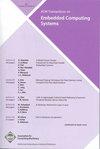通过旋转低功耗状态和部分通道关闭的3D存储器的动态热管理
IF 2.8
3区 计算机科学
Q2 COMPUTER SCIENCE, HARDWARE & ARCHITECTURE
引用次数: 0
摘要
现代高性能和高带宽三维(3D)存储器的特点是频繁加热。现有技术建议关闭热通道并将数据迁移到后台DDR内存,这会导致显著的性能和能源开销。我们提出了三种3D存储器的动态热管理(DTM)方法,以减少这些开销。第一种方法是基于旋转通道低功耗状态的DTM (RL-DTM),通过避免数据迁移将能量开销降至最低。RL-DTM将3D存储通道置于低功耗状态,而不是关闭它们。由于在低功耗状态期间不允许数据访问,因此RL-DTM平衡了每个通道的低功耗状态持续时间。第二种方法是掩膜旋转信道低功耗状态DTM (ML-DTM),它是一种细粒度策略,通过考虑信道访问速率来最小化能量延迟积(EDP)并提高RL-DTM的性能。第三种策略,部分通道关闭和ML-DTM,通过仅部分关闭通道并集成ML-DTM,减少被关闭的通道数量,将现有的基于通道级关闭策略的性能开销降至最低。我们使用各种SPEC基准测试和多线程工作负载的混合来评估建议的DTM策略,并观察它们与不同3D内存架构的最先进方法相比,显着提高了性能、能源和EDP。本文章由计算机程序翻译,如有差异,请以英文原文为准。
Dynamic Thermal Management of 3D Memory through Rotating Low Power States and Partial Channel Closure
Modern high-performance and high-bandwidth three-dimensional (3D) memories are characterized by frequent heating. Prior art suggests turning off hot channels and migrating data to the background DDR memory, incurring significant performance and energy overheads. We propose three Dynamic Thermal Management (DTM) approaches for 3D memories, reducing these overheads. The first approach, Rotating-channel Low-power-state-based DTM (RL-DTM) , minimizes the energy overheads by avoiding data migration. RL-DTM places 3D memory channels into low power states instead of turning them off. Since data accesses are disallowed during low power state, RL-DTM balances each channel’s low-power-state duration. The second approach, Masked rotating-channel Low-power-state-based DTM (ML-DTM) , is a fine-grained policy that minimizes the energy-delay product (EDP) and improves the performance of RL-DTM by considering the channel access rate. The third strategy, Partial channel closure and ML-DTM , minimizes performance overheads of existing channel-level turn-off-based policies by closing a channel only partially and integrating ML-DTM, reducing the number of channels being turned off. We evaluate the proposed DTM policies using various mixes of SPEC benchmarks and multi-threaded workloads and observe them to significantly improve performance, energy, and EDP over state-of-the-art approaches for different 3D memory architectures.
求助全文
通过发布文献求助,成功后即可免费获取论文全文。
去求助
来源期刊

ACM Transactions on Embedded Computing Systems
工程技术-计算机:软件工程
CiteScore
3.70
自引率
0.00%
发文量
138
审稿时长
6 months
期刊介绍:
The design of embedded computing systems, both the software and hardware, increasingly relies on sophisticated algorithms, analytical models, and methodologies. ACM Transactions on Embedded Computing Systems (TECS) aims to present the leading work relating to the analysis, design, behavior, and experience with embedded computing systems.
 求助内容:
求助内容: 应助结果提醒方式:
应助结果提醒方式:


